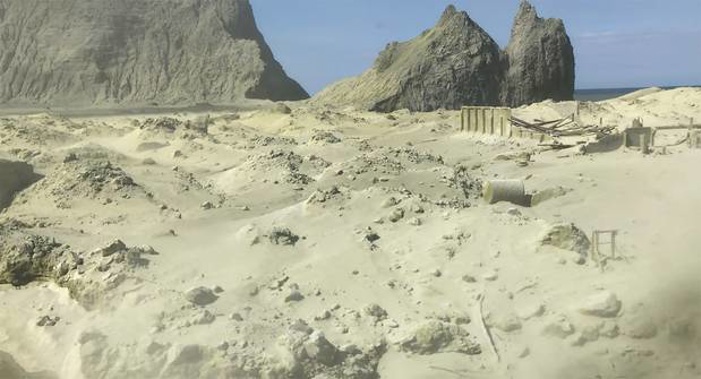
Scientists have described how the fatal eruption has changed the face of White Island by widening its crater area, tearing open more vents and blowing out its famous acid-green lake.
The bodies of two of 15 people who died following the December 9 blast are believed to remain on the island, but a recovery team was unable to locate them this morning.
The latest observations showed about 90 per cent of the ash and debris thrown out by the eruption had been contained to the main crater, which made up just under half of the island's area.
The active vent area, where the eruption blew from, had been enlarged by 10 to 30m – and several new vents had been created.
"There are now two or three new vents and at least two are producing the jetting steam and gas bursts," GNS Science volcanologist Brad Scott said.
GNS Science has just given a 30 to 45 per cent chance of another eruption within the next 24 hours which would have impacts outside the vent area.
The other dramatic change was the remnants of the surge, which now covered the crater's floor and walls.
But it wasn't clear how thick this material - much of it sand and gravel - was.
"It will be variable, but we can estimate it is 20cm to 30cm thick in places like around the helicopter pad."
Scott said the crater lake had been blown out, and although the basin it sat in was still present, it had been in-filled by eruption deposits.
While the volcano was known to belch out a high amount of SO2 gas – around 800 tonnes of it normally rose from its bowels each day – levels increased dramatically after the eruption.
In the blow itself, about 300 tonnes of SO2 was thrown up.
While the volcano was emitting around 660 tonnes a day of SO2 on November 18, when GNS Science raised the Volcanic Alert Level to 2, by the day after the eruption, that daily level was 1150 tonnes.
And by December 12, SO2 levels had risen to 1941 tonnes a day.
Levels of another colourless volcanic gas, hydrogen sulphide, had also risen from 11 tonnes per day on November 18 to 14 tonnes on December 10, and 29 tonnes on December 12.
Last week, volcanologists told the Herald that what would play out over coming weeks depended on a shallow body of magma sitting below the crater area.
While there was no clear guidance as to how another eruption might develop, Scott said one potential scenario was a further explosion that would send up another ash cloud.
Another was lava being squeezed out, which may come to appear as a black, craggy lava dome, plugging magma just below the surface.
Although last week's eruption was White Island's biggest episode in recent times, the island had gone through change after change since its current period of unrest kicked off back in 2011.
In August 2012 came its first eruption since 2001 – an event that might have drawn more media coverage had Mt Tongariro not just thrown a tantrum of its own.
Lava was extruded a few months later, before the crater lake vanished and reformed again.
In October 2013, the volcano blew again, with a moderate eruption that could have killed anyone who was near at the time.
More eruptions came in April and September 2016 – the former proving powerful enough to blow 13m to 15m of the crater lake floor out of the volcano, and leaving it covered in a green-tinged ash, with a hot, dry consistency like that of apple crumble.
Again, the lake disappeared, only to return last year, for the fourth time since the start of the decade, with help from heavy rainfall from cyclones.
For scientists, the crater floor area had been designated a no-go zone, with access to the seaward sides of the volcano only being permitted in "exceptional circumstances".
Scott said the volcano would continue to be watched through seismic, acoustic and camera remote sensing equipment located on the island, as well as with observations from flights.
Take your Radio, Podcasts and Music with you









